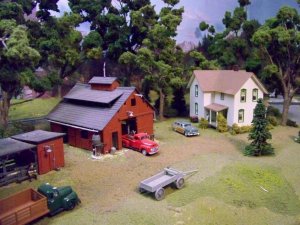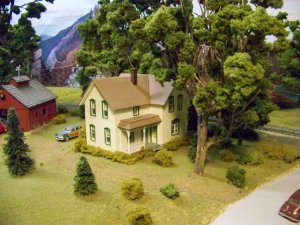One other consideration with a grade is whether it is a straight line or a grade built on a radius or curve. Pulling up a 3% curved grade puts a bit more load on the engine than if it were pulling the same train up a straight line 3% grade. I have two 3% grades on 24 inch radius curves. All my 6 axle diesels pull up no problem. Several of my 4 axle units need to be double headed to pull the same length train up those grades. On a previous layout I had a 3% straight line grade and could pull with only one 4 axle unit.
You are using an out of date browser. It may not display this or other websites correctly.
You should upgrade or use an alternative browser.
You should upgrade or use an alternative browser.
grade question
- Thread starter jim81147
- Start date
Yes, curves add to the stress on the train. Engineers call it compensation, we usually don't worry about it. I have a sharp curve and 6% grade on my branchline. Because of a mistake in alignment laying down the foam underneath, I have a slight kink in the curve and the steepest part of the grade at the bottom of the hill. I massaged it as much as I could without tearing out the entire alignment. My Plymouth switcher will push two hoppers or one Boxcar up the grade. It takes full speed at the bottom to get over that spot. Coming down I have derailments when I try to haul more than 3 cars.
Sent from my XT1080 using Tapatalk
Sent from my XT1080 using Tapatalk
Montanan mentioned "Superelevation" i.e. banking or tilting of the track towards the inside of the curve, something that real RRd's use to allow trains to negotiate curves at speed. Modellers, unless they are going to operate at speeds well in excess of prototypical, do it to copy the appearance (which is one of the visually pleasing aspects of real operation). We have to be careful, especially with long trains because the weight of the cars trailing behind the curve will just pull the ones on the curve, inwards and off the track.
I say this because there is a curve on a 24"+ radius on the club layout, where a crawl is the only way to get around it, go any quicker and you'll dump your rolling stock down in the "ditch" next to it.
I say this because there is a curve on a 24"+ radius on the club layout, where a crawl is the only way to get around it, go any quicker and you'll dump your rolling stock down in the "ditch" next to it.
D&J RailRoad
Professor of HO
Super elevation on a MRR has to be moderated with the radii of the curve. 24" radius curves are common on layouts and will contribute to the pulling the train over if to much stress or pull is applied. I would post another video of a super elevation example but I'm on my droid which makes it very difficult to link from YouTube.
Iron Horseman
Well-Known Member
And I still have children wondering why they need to know Algebra.Thanks! THAT is the most clearly understandable explanation of this I've ever seen!
montanan
Whiskey Merchant
Sorry that I opened a can of worms with the super elevation statement. I would not recommend it on tight curves. 24 inch is a tight turn. My minimum radius is 32 inches, which is in a town, and on a grade crossing. It is not super elevated. The rest of my curves range from 46 to 52 inches. This was sort of a big thing 25 years ago. To get the super elevation, I shimmed the outer rail with strips of poster board. I guess that is perhaps a thirty second of an inch. I have a 2% grade ending in a curve at the top. It does make a difference to haw many cars can be pulled through a curve. This farm is at the top of the grade. It is over a 48 inch radius.


In this photo, the super elevation ends about 6 inches past the signal. You might be able to see the freight cars behind the locomotive in the super elevated track.

If you look at the cab ride video in my signature, you can make out the super elevation at the top of the grade after leaving the yard.
I have pulled a 60 plus car long train up the grade needing three locomotives and nothing capsized, but all of my cars are properly weighted.


In this photo, the super elevation ends about 6 inches past the signal. You might be able to see the freight cars behind the locomotive in the super elevated track.

If you look at the cab ride video in my signature, you can make out the super elevation at the top of the grade after leaving the yard.
I have pulled a 60 plus car long train up the grade needing three locomotives and nothing capsized, but all of my cars are properly weighted.
Last edited by a moderator:
Wasn't a can o' worms Chett, just a warning not to get carried away with it. This particular curve I referred to is on the top inner track and a reversing loop to boot, of a peninsular end. Looks great to see the trains leaning into it, but it's got to be ripped out. Too impractical. In fact it could do with some negative superelevation.
new guy
Active Member
And I still have children wondering why they need to know Algebra.
Alga-what? LOL!

